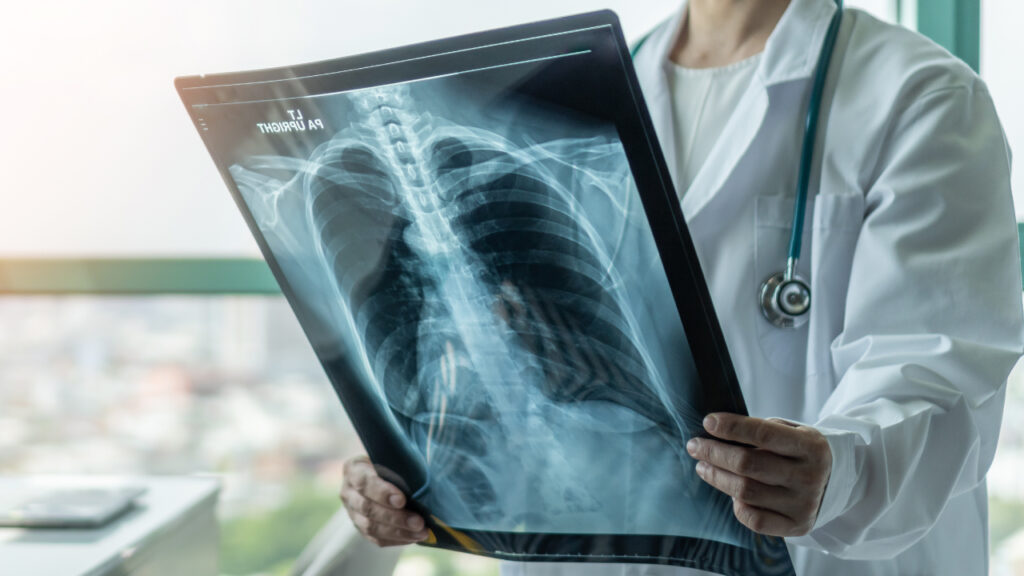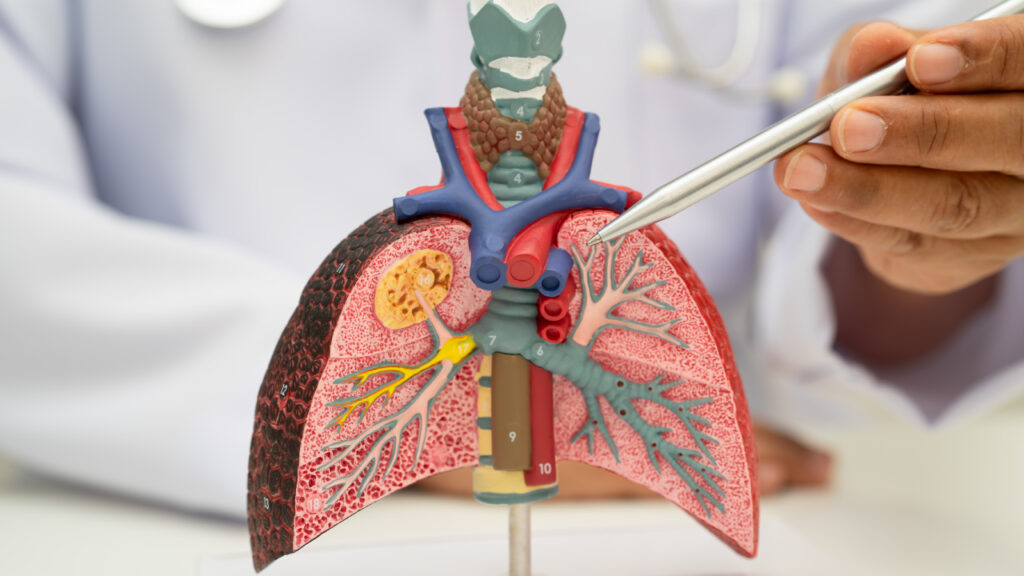Did you know that there are around 800,000 people with COPD in Portugal and that 7 out of 10 don’t even know they have the disease ?
It’s just that the signs often seem like everyday tiredness: a persistent cough, shortness of breath when climbing stairs, a chest that tightens in the cold. The body resists until breathing is no longer so simple. And that’s when COPD is discovered – an invisible but real disease that needs to be recognized before it progresses in silence.
Key points of the article
- COPD is a chronic and progressive respiratory disease that affects around 800,000 people in Portugal
- Persistent coughing, shortness of breath and tiredness are common but often overlooked symptoms
- The main cause is smoking, although exposure to dust, fumes and genetic factors can also contribute
- Diagnosis is made with spirometry, but 70% of cases remain unidentified
- There is no cure, but it can be stopped with proper treatment, respiratory rehabilitation and lifestyle changes
- Prevention, early diagnosis and follow-up are essential for improving quality of life.
COPD: what is it?
It’s not a single disease, but rather an umbrella that combines two chronic respiratory conditions: chronic bronchitis and pulmonary emphysema. Both cause obstruction of the airways, making it difficult for air to pass through and making breathing a real effort.
The obstruction doesn’t go away on its own and gets worse over time, especially if it isn’t diagnosed and monitored. But it’s not all bad news: with the right treatment and a few lifestyle changes, it’s possible to live better with COPD.
Causes and risk factors
The big villain has a familiar name: tobacco. Smoking for years is the main cause of COPD.
But there are other factors to take into account:
- Exposure to dust, fumes and chemicals, especially in the workplace
- Air pollution, especially in urban areas
- Smoke from fireplaces, common in poorly ventilated houses in rural areas
- Common respiratory infections in childhood
- Family history or genetic deficiency (such as the rare but relevant absence of the alpha-1-antitrypsin protein).
It’s important to emphasize: not all smokers get COPD, but the longer and more you smoke, the greater the risk. And, of course, those who already have asthma or other respiratory diseases are even more vulnerable.
COPD: symptoms
COPD comes on slowly, often silently. For this reason, the first symptoms are easily overlooked. But there are signs to look out for:
- Chronic, dry or expectorating cough (often associated with smoking and therefore ignored)
- Wheezing (a high-pitched sound when breathing)
- A feeling of tightness in the chest
- Shortness of breath (dyspnea), first on exertion, then even at rest
- Constant tiredness and limited daily activities
- In more advanced stages: anxiety, weight loss, frequent respiratory infections and even bluish fingers (a sign of lack of oxygen).
How is the diagnosis made?
The progression is slow but continuous, which is why identifying the problem early makes all the difference. The most commonly used test to confirm the diagnosis is spirometry – a simple but essential test that measures how much air the lungs can breathe in and out. It can also be complemented with:
- X-ray or chest CT scan (to detect emphysema and exclude other diseases)
- Blood tests and arterial blood gases (to measure oxygen and carbon dioxide levels)
- Evaluation of genetic deficiency of alpha-1-antitrypsin in suspected cases.
If there is a persistent cough, expectoration, tiredness and a history of smoking or exposure to irritants, it is always worth making an appointment with a pulmonologist.
COPD in Portugal: the weight of the numbers and the experts' warning
Despite affecting around 800,000 people in Portugal, COPD remains largely unknown to the population. It is estimated that
This scenario has led to the creation of various awareness and research initiatives, such as the Respiratory Health Forum 2025 which advocates an integrated response to the respiratory disease crisis, and the new national study promoted by the Portuguese Society of Pneumology and AstraZeneca Portugal, which will help outline the clinical and therapeutic profile of COPD patients in Portugal. The aim is clear: to improve early diagnosis, personalize care and guarantee a fairer and more accessible response to the population.

COPD GOLD: what is it and how is it measured?
The GOLD classification (Global Initiative for Chronic Obstructive Lung Disease) is used internationally to assess the degree of obstruction and guide treatment, and helps doctors choose the most appropriate treatment plan for each patient.
It is based on the results of spirometry and divides COPD into four stages:
- GOLD 1 (Mild): mild symptoms, little impact on daily life
- GOLD 2 (Moderate): more shortness of breath, limitations to physical exertion
- GOLD 3 (Severe): greater functional limitation and risk of exacerbations
- GOLD 4 (Very severe): constant symptoms and risk of respiratory failure.
COPD treatment
COPD has no cure, but it does have treatment. And the sooner it starts, the greater the benefits.
Key measures
- Stop smoking. It’s the most important step and the only one that can halt the progression of the disease;
- Avoid polluted environments or those with toxic fumes
- Annual flu and pneumococcal vaccination to prevent infections
- Respiratory physiotherapy and pulmonary rehabilitation, which help restore physical and respiratory capacity.
Medicines available
- Bronchodilators (short or long-acting inhalers): help open up the airways and make breathing easier
- Inhaled corticosteroids, which reduce inflammation and prevent seizures
- Antibiotics, when there are respiratory infections
- Oxygen therapy, in cases where oxygen levels are low
- Non-invasive ventilation (with a mask), in more serious situations.
In more advanced cases, lung volume reduction surgery or, ultimately, lung transplantation may be considered.
How long does a COPD patient live?
Rather than counting the years, the important thing is to make the days better. How long you live after diagnosis depends on several factors: age, the severity of the disease, the presence of other conditions and, above all, whether you continue to smoke. In general:
- Those with mild to moderate COPD who have good control of the disease can live many years with quality
- In the more advanced stages, the prognosis is more guarded, but the right treatment can prolong life and improve symptoms.
Living with COPD: adapting the body, taking care of the mind and moving on
Living with COPD requires adjustments. It’s true that the disease imposes limits (on the body, on breath, on routines) but it’s also true that there’s a lot that can be done to make everyday life lighter, more breathable.
And it’s not just about medication. Taking care of your body and mind makes all the difference:
- Learning breathing techniques, with the help of a physiotherapist, can help to better manage moments of difficulty
- Regular physical exercise, adapted to each person’s ability, helps maintain mobility and muscle strength
- Eating a balanced diet that prevents weight loss or excess fat improves energy and respiratory capacity
- Avoiding places with smoke or pollution is essential to protect the lungs
- Taking care of your emotional health, talking about your fears and seeking psychological support can ease the burden of anxiety that so often accompanies shortness of breath.
Breathing may take more work, but it’s still possible. And every breath counts. If you suspect you may have COPD, don’t put it off. A timely diagnosis can change everything. And if you’re already living with the disease, remember: there are always ways to take care of it, adapt and carry on living.




